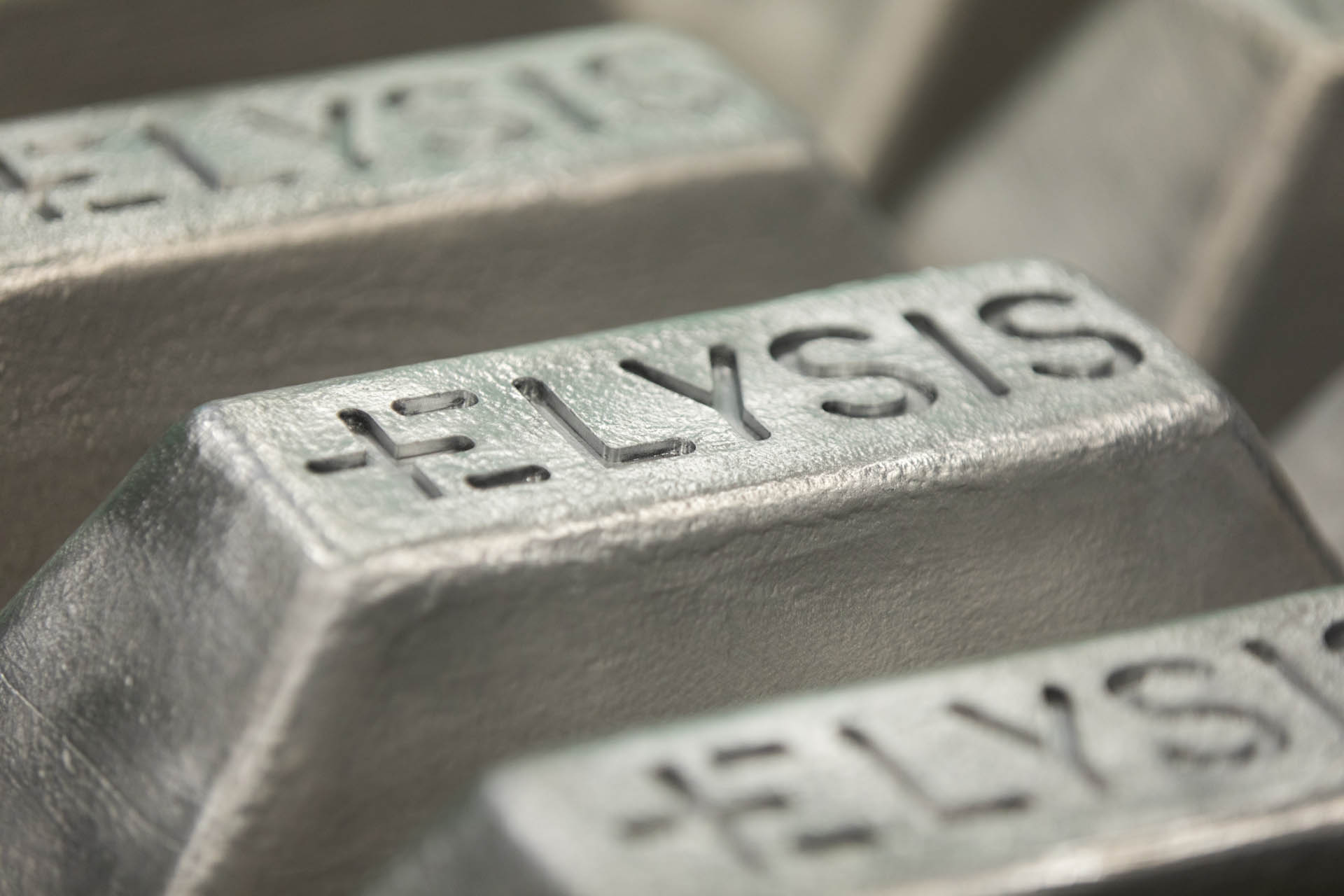Aluminium is lightweight, strong, and infinitely recyclable. It is also the leading choice for sustainable product development. Aluminium is essential for low-carbon solutions, including lightweight cars and energy efficient buildings – its weakness is that it takes a lot of energy to produce it – also because its production processes have been essentially the same since 1886.
The main challenge for aluminium – as a material for the green transition – is therefore to find ways to decarbonise the way it is made, by ensuring that the electricity used for smelting is renewable, and that we eliminate the use of carbon anodes in the smelting process itself, and it is on this latter point, where we have made a breakthrough.
Smelting aluminium – GHG-free
In 2018 we partnered with Alcoa, supported by Apple and the Governments of Canada and Quebec, on ELYSIS™, a joint venture to help further develop breakthrough aluminium smelting technology that produces no direct greenhouse gas (GHG) emissions. In November 2021, ELYSIS successfully produced GHG-emission-free aluminium at its Industrial Research and Development Center in Saguenay, Quebec, Canada.
The ELYSIS™ technology effectively puts an end to the use of carbon anode in the aluminium smelting process. Over the last one hundred years, manufacturing of aluminium has involved an electrolytic process where aluminium oxide dissolved in a fluoride-based molten electrolyte is split into aluminium and oxygen. The aluminium is recovered in molten form and the oxygen reacts with the carbon anode to produce CO2, and in doing so consumes the carbon anode. ELYSIS™ features newly developed breakthrough proprietary materials that are stable and are not consumed during the process. Thus, it eliminates all direct greenhouse gas (GHG) emissions from the aluminium smelting process and only emits oxygen as its by-product. This is a fundamental change of a hundred-year-old manufacturing process.
ELYSIS™ technology has the potential to transform the aluminium industry through a significant reduction in its carbon footprint. In Canada alone, the use of ELYSIS™ technology could reduce GHG emissions by 6.5 million metric tons – the equivalent of removing 1.8 million cars from the roads.
Does this innovation have a future? It certainly does. First, the ELYSIS™ technology – which can be used in both new and existing aluminium smelters – will reduce operating costs at aluminium smelters, while increasing production capacity. Second, demand is basically assured, as it will allow aluminium customers to decarbonise their supply chain, in line with growing demand from consumers. Aluminium produced during the ELYSIS™ research and development stage has already been used by Apple, ABInBev for Michelob Ultra cans and Audi for the wheels on its eTron GT.

Scaling up for commercialisation
Following the breakthrough in 2021, there is still more work to do before the technology can be used commercially. The focus is now on accelerating the scale-up of the technology towards the demonstration of even larger commercial-size cells in 2023.
Construction of these prototype cells is well underway at our Alma aluminium smelter. With the current development pathway, ELYSIS aims to have its technology available for installation from 2024 and the production of larger volumes of carbon-free aluminium approximately two years later.
Shared conviction – joint action
No company alone will solve the decarbonisation challenge. We need to collaborate across our supply chain, including partnerships with customers, technology providers, research institutes, government, and other stakeholders.
Rio Tinto, Alcoa, the Government of Canada and the Government of Quebec provided a combined investment of CAD 228 million to create ELYSIS and to see this technology reach commercial maturity. The Canadian Government and the Quebec Government, through the participation of Investment Quebec, have decided to support and be part of this industry revolution, each investing CAD 80 million in ELYSIS. Their support has ensured that this breakthrough technology and the birth of a revolutionary new aluminium smelting industry took place in Quebec.
World technology giant Apple helped facilitate the collaboration between Alcoa and Rio Tinto on the carbon-free smelting process and, in addition to investing CAD 13 million, has agreed to provide ELYSIS with technical support.
ELYSIS is an excellent example of industrial partnerships bringing together competitors, customers, and governments to facilitate breakthrough technologies and investments in R&D.
Potential for Europe
A key reason why we chose to develop the ELYSIS™ technology in Canada was the abundance of renewable energy. Combined, Rio Tinto and Alcoa operate 10 aluminium smelters in Canada, all using 100% renewable energy. Access to green energy ensures that aluminium produced by ELYSIS is 100% carbon neutral. But that was only one reason.
Both governments had a vision that this new technology should see the light of day on their turf – and they followed this through hands-on. The EU on the other hand, whilst visionary on the green transition and newly ambitious with its Green Deal Industrial Plan, seems to have a much more complex – even reluctant – relationship with public investment in private sector initiatives. This has to change if Europe’s political class wants to see new breakthrough technologies being developed in Europe and contributing to the long-term competitiveness of European industry. If we could make it speedier and more accessible, the Important Project of Common European Interest (IPCEI) model would be ideally suited to bring partners together along the value chain.
The global competitiveness of technologies such as ELYSIS™ will depend on whether policymakers will ensure that the true cost of carbon is priced in. A market-based price on carbon is the most effective way to incentivise the private sector to make low-carbon investments and drive down emissions. A range of policy measures is necessary to support the early movers in our sector that innovate and deploy low-carbon technology.

